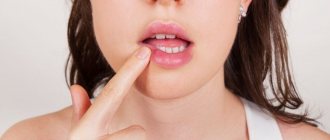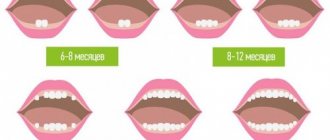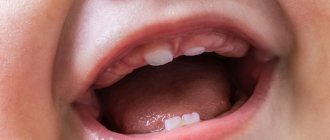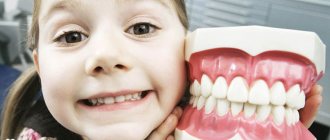Orthodontist-dentist Nikolaeva Nadezhda Nikolaevna
Bleeding gums is a very common symptom that accompanies dental diseases such as gingivitis, periodontitis and some general somatic diseases. When gums bleed, treatment depends on the pathology that caused the symptom. Depending on the severity of the disease, bleeding can be pronounced or almost invisible. In people with an initial degree of severity, blood appears only during cleaning , and in people with a severe course it can appear spontaneously .
With mild bleeding, patients rarely seek dental care, either without taking any action at all or self-medicating. Only other serious signs force the patient to look for the causes and treat bleeding gums.
There are two extremes characteristic of self-treatment - stopping brushing teeth or vice versa, excessive attention and diligence when brushing, uncontrolled use of antiseptics and gels. Since bleeding is only a symptom, without eliminating the immediate cause of bleeding, the patient’s actions will be ineffective. There are a sufficient number of pathological conditions of the body in which the gums begin to bleed, but the immediate cause is tartar .
With poor oral hygiene, soft plaque accumulates on the teeth, often around the necks of the teeth. Over time, plaque crystallizes and can no longer be removed with a toothbrush. As it grows, it penetrates the gingival sulcus, destroying the periodontium and the capillaries that feed it. Bacteria living in dental plaque produce lactic acid and toxins that cause inflammation. Thus, it is rational, as soon as inflammation and bleeding gums are detected, treatment should begin with the removal of supra- and subgingival stones.
Only inflammatory processes that occur during pregnancy and puberty in adolescents are not related to hygiene. One important nuance should be noted if pregnant women have bleeding gums - the gynecologist decides how to treat, since there are quite a lot of procedures and medications that are prohibited during pregnancy.
Causes of bleeding gums
If you notice your gums are bleeding, before you panic, first consider whether you might:
- mechanically damage the interdental spaces when using floss (dental floss). In this case, it is worth treating the oral cavity with an antiseptic solution of chlorhexidine 2-3 times a day, rinsing with calendula decoction
- replace a regular toothbrush with an electric one. Bleeding is normal the first few times you use an electric toothbrush. This usually goes away completely within 2-3 days. If not, contact your dentist, start rinsing with an antiseptic, and stop using the power brush until you receive further instructions from your doctor.
- Using an oral irrigator incorrectly. Often new owners of such an indispensable device as an irrigator immediately begin to treat the oral cavity with a high-pressure stream of water instead of allowing the tissues to adapt. In this case, it is worth temporarily filling the irrigator container with chlorhexidine, either pure or mixed with water, and cleaning at the minimum power level. Typically, symptoms should completely disappear within a couple of days.
Also, bleeding gums are not a rare occurrence in pregnant women as a result of powerful hormonal changes. During this period, you need to treat your teeth with increased attention and care.
None of the above? Then there is a high probability of an inflammatory process in the tissues. In the early stages, you may notice slight bleeding and slight swelling - signs of gingivitis. Ignoring the symptoms can lead to the development of pain and the onset of suppuration, which will indicate the transition of the disease to a dangerous stage of periodontitis.
Why does the gums around the crown become inflamed?
In addition to mechanical damage, the gums can react with swelling due to the irritating effect on it of chemicals contained in oral hygiene products - toothpaste, rinses.
However, swelling of the gums near the tooth under the crown can be caused by more serious reasons. For example, swelling may be a sign of:
- Gingivitis or periodontitis. It usually appears due to poor oral hygiene, the presence of dental plaque, malocclusion, poorly fitting crowns, as well as hypovitaminosis and endocrine disruptions. At first, the gums swell and bleed, darkening of the gums around the tooth at the crown may be observed, and later suppuration and tooth mobility occur.
- Flux, or periostitis. This disease affects the hard periodontal tissues and, in particular, the periosteum of the jaw. Very often, tooth flux under the crown is a consequence of asymptomatic pulpitis or periodontitis. If the flux is not treated, there are two possible options for the development of the disease - involution of the flux and its spontaneous opening. In the second case, a fistula forms on the gum (tooth under the crown), through which purulent contents flow. In this case, the pain subsides, but the inflammatory process itself continues and without appropriate treatment, osteomyelitis of the jaw can form.
- Alveolar process abscess is another complication of pulpitis, periodontitis or caries occurring in the tooth under the crown. With this disease, the patient will complain not only of swollen gums above the crown of the tooth, but also of severe pain in the jaw, aggravated by exposure to heat, facial asymmetry, and unilateral enlargement of the submandibular and cervical lymph nodes.
- Overloading a denture with irrational prosthetics can lead to the tooth crown moving away from the gum and food starting to get clogged under it. As a result, mobility of the supporting teeth appears, and the soft tissues of the oral cavity become inflamed (gingivitis).
Methods for treating bleeding gums
The treatment that's right for you depends on the cause of your symptoms.
As we have already mentioned, if you notice bleeding as a result of careless manipulations with floss when performing oral hygiene, changed your toothbrush, started using an irrigator, or are pregnant, you can fix the problem yourself. It is enough to rinse with antiseptic compounds and temporarily reduce the load.
In case of gingivitis, you should contact your dentist as soon as possible. The doctor will examine your teeth for tartar and plaque. Perhaps the problem will be solved after professional cleaning and removal of unwanted deposits in which bacteria multiply. Additionally, local anti-inflammatory drugs (Metrogil Denta, Cholisal) and chlorhexidine rinses may be prescribed.
If the gums are very inflamed and painful, more radical actions may be required:
- Surgical cleaning of periodontal pockets. This technique is called “curettage” and provides a closed type of treatment (without cutting the gums) if the pockets are not deep and an open one (with cutting the gums) if the closed one does not produce results.
- Gum plastic surgery. The procedure is used in advanced, especially severe cases of periodontitis. The doctor either removes excess tissue or, on the contrary, builds up the gum. The operation is low-traumatic and quite effective, especially in combination with treatment with anti-inflammatory drugs and (if necessary) antibiotics
Causes
The most common factors that lead to bleeding gums are:
- Improper oral hygiene:
using a brush with hard bristles, strong pressure when brushing, inaccurate use of dental floss, picking with toothpicks and other objects, improper installation of dentures. Due to frequent trauma, gum pockets form, which provoke inflammation.
- Tartar.
With irregular and improper brushing of teeth, plaque forms, which gradually hardens. The stone moves the gum away from the tooth, the tissue becomes inflamed and begins to bleed.
- Dental procedures.
Bleeding may occur after professional cleaning, tooth extraction, or the installation of a filling or implant. A poorly manufactured or fitted structure constantly injures the edge of the gum. In addition, filling material and dentures can cause an allergic reaction.
- Diseases of gums and teeth:
gingivitis, periodontitis, periodontal disease. Inflammatory processes are accompanied by swelling, swelling, exposure of the neck, abrasion and loosening of teeth.
- Infections and viruses.
Herpes, fungus, tonsillitis, influenza, ARVI, tuberculosis, HIV lead to the destruction of the periodontal structure and provoke inflammatory processes in the oral cavity.
- Hypovitaminosis.
Bleeding from the gums occurs when there is a deficiency of vitamins B, K, C, E. A monotonous and unbalanced diet, frequent diets, and inducing vomiting lead to pathology. With a lack of vitamin C, scurvy can develop. During the disease, teeth become loose and begin to fall out.
- Hormonal disbalance.
The problem is observed during pregnancy and puberty, with diabetes. Due to an imbalance of biologically active substances, tissues swell and become looser. In this case, bleeding from the gums occurs not only when brushing teeth and eating solid food, but also from the slightest touch.
- Taking a number of medications.
Blood thinners, including Aspirin, Heparin, and Warfarin, can lead to the problem. Some nonsteroidal anti-inflammatory drugs have similar side effects.
- Blood diseases.
Bleeding disorders often lead to gum pathology: hemophilia, thrombocytopenia. The condition of the mucous membranes also worsens with tumor processes - leukemia and leukemia.
conclusions
Carefully monitor the health of your teeth and oral cavity. Use dental floss and irrigator carefully. In case of gum swelling, pain and bleeding, it is better to immediately seek professional help. This will allow you to stop the problem in a timely manner and prevent it from developing into periodontitis.
Don't neglect professional teeth cleaning. Remove tartar and plaque at least once a year. More often if you have dentures, implants and/or smoke.
Strictly follow your doctor's instructions, especially with regard to taking antibiotics and using medicinal ointments and solutions.
What to do if your gums are bleeding?
If blood appears regularly while eating or brushing with a toothbrush, you need to be examined by a periodontist. The doctor will check the condition of the teeth and gums, prescribe treatment, and carry out the necessary procedures.
If the gums are bleeding due to mechanical trauma, it must be ruled out. If it occurs when brushing your teeth, change the toothbrush to a softer one and stop using dental floss. If the cause of the injury is braces, dentures or incorrectly installed fillings, they are corrected. If the appearance of blood is associated with the habit of chewing a pencil, toothpick or other objects, they try to control it.
If the cause is inflammation, it needs to be removed. Before this, sanitation of the oral cavity can be carried out. The doctor may recommend antibiotic therapy and prescribe anti-inflammatory drugs. If inflammation develops due to the accumulation of tartar on the cervical part of the teeth, professional hygiene and cleaning of periodontal pockets are carried out.
Also, to strengthen the gums, the doctor may recommend taking vitamins, physiotherapeutic procedures, and using an irrigator in massage mode.
If your teeth bleed when brushing
Bleeding gums occur due to gingivitis. In itself, it does not cause major problems, but it is the first symptom of the development of such a serious disease as periodontal disease. Bleeding primarily occurs when brushing your teeth or when you have to bite something hard. It is better to deal with this symptom as early as possible, before the next stage of the disease appears - exposure of the necks of the teeth.
How does the situation develop if nothing is done?
At first, when brushing your teeth, a little blood comes out of your gums. This usually begins after gum swelling has appeared. This is the stage of gingivitis. After some time, pain, loosening of the teeth and exposure of their necks appear. A full range of symptoms of periodontitis occurs. This already causes anxiety for the patient. In the absence of adequate treatment, the final stage occurs - periodontal disease. This disease leads to complete loss of teeth
How to treat bleeding gums?
The only treatment method is to remove tartar and plaque. It is best to start by ordering a professional ultrasound tartar removal procedure from your dentist. Then you need to purchase the softest and fluffiest toothbrush possible and thoroughly brush your teeth with it in the morning and evening for at least three minutes. Instead of tooth powder, it is better to use ash and rinse your mouth with hot water - you will immediately notice how much more effectively your teeth are cleaned with this method.
Treating bleeding gums at home
- First of all, it is necessary to remove tartar. For this purpose, use grated black radish with lemon juice, chew it thoroughly and brush your teeth with it for at least 3 minutes every evening. The second most effective remedy is a decoction of walnut bark - pour 2 tablespoons of dry bark into a glass of cold water, bring to a boil and boil for 15 minutes. You also need to brush your teeth and rinse your mouth for at least 5 minutes every evening.
- The second stage is removing inflammation from the gums. A decoction of sage or oak bark works best here. Two tablespoons of sage or 2 teaspoons of bark per glass of boiling water. Boil in a water bath for 10 minutes. Rinse your mouth every four hours if possible. It should be borne in mind that oak bark somewhat darkens the color of the teeth.
- For internal prevention of the disease, you need to eat at least 400 g of cottage cheese per week and every day - something with vitamin C (kiwi, a cup of rosehip decoction with sugar, lemon, black currant, etc.).
Prevention
According to US standards, you need to have professional ultrasonic cleaning of teeth to remove tartar at least three times a year. This is mandatory, but it should be borne in mind that such cleaning is not a panacea, since if you do not brush your teeth, the stone will form again within a week. Therefore, you need to thoroughly brush your teeth twice a day with a soft toothbrush, so that it is not scary to press it hard. It is better to use ash instead of powder and rinse your mouth with hot water. After cleansing, you can use one of the following: chew a slice of fresh ginger, rinse your mouth with a homemade lactic acid product, gargle with sage, or chew grated radish. It is better to alternate the product used from time to time.








